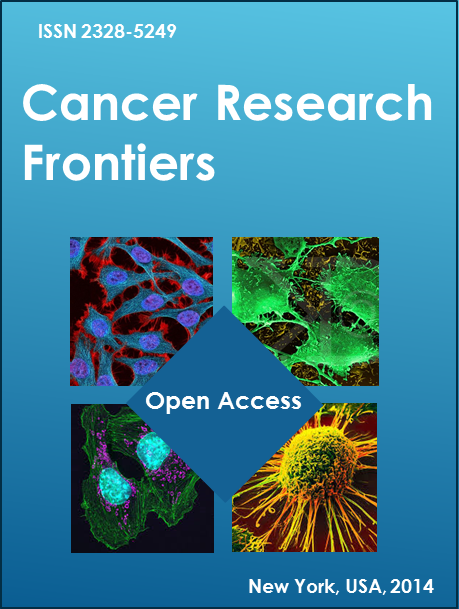Abstract _ Full Text (HTML) _ Full Text (PDF)
Review
Cancer Research Frontiers. 2017; 3(1): 144-156. doi: 10.17980/2017.144
Roles of Glypican-3 through IGF axis and Wnt in Hepatocellular Carcinomas
Wei Cheng1-3, Shu-Hsiang Liu3, Wuh-Liang Hwu4, Yu-May Lee4-6
1Department of Pathology, Kee-Lung Hospital, Ministry of Health and Welfare, Kee-Lung, Taiwan
2Ching Kuo institute of Management and health, Kee-Lung, Taiwan
3School of Nursing, National Taipei University of Nursing and Health Sciences, Taiwan
4Department of Medical Genetics, National Taiwan University Hospital, Taipei, Taiwan
5Institute of Biological Chemistry, Academia Sinica, Taipei, Taiwan
6Institute of Biochemical Sciences, National Taiwan University, Taipei, Taiwan
*Corresponding author: Yu-May Lee, email:
Citation: Wei Cheng, et al. Roles of Glypican-3 through IGF axis and Wnt in Hepatocellular Carcinomas. Cancer Research Frontiers. 2017; 3(1): 144-156. doi: 10.17980/2017.144
Copyright: @ 2017 Wei Cheng, et al. This is an open-access article distributed under the terms of the Creative Commons Attribution License, which permits unrestricted use, distribution, and reproduction in any medium, provided the original author and source are credited.
Competing Interests: The authors declare no competing financial interests.
Received Jan 9, 2018; Revised Mar 15, 2018; Accepted Mar 20, 2018. Published Mar 31, 2018
Abstract:
Glypican-3 (GPC3) is overexpressed in more than 70% of hepatocellular carcinomas (HCCs) and also in Wilms’ tumor, hepatoblastoma, melanoma, and neuroblastoma. Considerable evidences indicate that GPC3 alters the growth of cancer cells through a few different mechanisms. For example, GPC3 stimulates both canonical and noncanonical Wnt signaling in cancer cells and GPC3 inhibits Hedgehog signaling during development. We and others further demonstrate the role of IGF-1R in GPC3-mediated oncogenicity. In this review, we summarize the mechanisms underlying the consequences of GPC3 overexpression in HCC. We also review current GPC3-targeted therapeutic approaches for HCC.
Keywords: glypican-3 (GPC3); insulin-like growth factor 1 receptor (IGF-1R); hepatocellular carcinoma (HCC).
Introduction
The role of Glypican-3 (GPC3) in cancers has been confusing until recently. GPC3 was reported to display loss-of-function mutations in patients with the Simpson-Golabi-Behmel Syndrome (SGBS), an X-linked disorder characterized by pre-and post-natal overgrowth, a broad spectrum of visceral and skeletal abnormalities, and an increased risk for the development of embryonic tumors (1). Being aware that the insulin-like growth factors (IGFs) play a critical role in the regulation of body size, Pilia et al., proposed that GPC3 was a negative regulator of IGF-2, and that the loss of functional GPC3 in the SGBS patients generated hyperactivation of IGF signaling. These findings together with cell line-specific promotion of apoptosis by rat GPC3 (2) suggest that GPC3 plays a negative role in cell proliferation and an apoptosis inducing role in specific tissues. Consistent with this idea, GPC3 is frequently silenced in ovarian cancer, mesotheliomas and breast cancer cell lines and ectopic expression of GPC3 inhibited the growth of these cells (3-5).
In contrast, GPC3 is frequently up regulated in hepatocellular carcinoma (HCC) (6, 7), neuroblastoma and Wilms’ tumor (8), hepatoblastoma (9) and melanoma (10). We and Filmus et al., found that Glypican-3 promotes the growth of HCC (11, 12). Therefore, GPC3 induces apoptosis or promoting cell growth in a cell line specific manner. This review is about the current knowledge on the structure and function of GPC3, the involvement of GPC3 in human pathologies, the different hypotheses with regard to the molecular basis of GPC3 function, and the improved therapies for HCCs in which GPC3 and these molecules are implicated.
Glypican-3 (GPC3) is a member of the GPC family
Glypican-3 (GPC3) is a glycosyl-phosphatidylinositol (GPI)-anchor heparan sulfate proteoglycan (HSPG) (13), and a member of the glypican family. Glypicans (GPCs) are heparan sulfate proteoglycans that are bound to the external surface of the plasma membrane by a GPI linkage (14). There are six glypican family members in the human genome (GPC1 to GPC6) (Fig. 1). Glypicans fall into two broad subfamilies: glypicans 1/2/4/6 and glypicans 3/5, with approximately 25% amino-acid identity between groups (15). Within the first subfamily, glypicans 4 and 6 are relatively closely related (64% identity) and glypicans 1 and 2 form a more divergent clade. A notable genomic feature of GPCs in the mouse and human genomes is the close linkage of genes that form two glypican clusters: glypicans 3/4 on the X chromosome (16, 17), and glypicans 5/6 on human chromosome 13 (mouse chromosome 14) (18, 19). Glypican proteins are between 555 and 580 amino acids in length, and encoded in eight to ten exons in human.
Structure of GPCs
Because of the lack of X-ray crystallography and other imaging data, knowledge of the three-dimensional structure of GPCs is limited. Furthermore, GPCs do not have domains that share significant homology with other characterized structures. However, the three-dimensional structure of GPCs appears to be highly conserved across the family, as the localization of 14 cysteine residues is preserved in all family members (20) and called cysteine-rich domain (CRD); whether this has functional implication remains unknown. Another noteworthy structural feature shared by all GPCs is the insertion sites for the heparan sulfate (HS) chains, a type of glycosaminoglycan (GAG) (Figure 1), which are located close to the carboxyl terminus (21, 22). This places the HS chains close to the cell surface, suggesting that these chains can mediate the interaction of GPCs with other cell-surface molecules, including growth factor receptors (13).
Most GPCs, including those of Drosophila (23), are processed by endoproteolytic cleavage by a furin-like convertase (22) (Figure 1). The cleavage site is located at the carboxy-terminal end of the CRD, and the cleavage generates two subunits that remain attached to each other by one or more disulfide bonds (22). After proteolysis by the convertases, the mature proteins/peptides are usually subjected to several other modifications necessary to achieve full bioactivity (24). Therefore, the cleavage of GPCs by furin-like convertase may be vital for their functions. GPC3 contains a proline-rich region located at residues 26–31, which is crucial for its association with insulin-like growth factor (IGF)-2 and IGF-1R and its internalization after IGF-1 treatment (12, 25).
Table 1. Summary of GPC3 associated pathways in cells or mice
Subcellular localization and function of GPCs
As expected for proteins carrying GPI anchors, GPCs are mostly found at the cell membrane (13, 14, 20, 26). In polarized cells, GPI-anchored proteins are usually located at the apical membrane and in the lipid rafts (27). Lipid rafts are cell-membrane subdomains that are glycolipid-enriched and detergent resistant (28-30). GPCs function as co-receptors for heparin-binding proteins, including growth factors, extracellular matrix molecules, and cell–cell adhesion molecules (31, 32). The binding of co-receptors may facilitate interactions between the heparin-binding factors and their respective receptors (3, 33). Cytoplasmic translocation of GPC3 has also been observed (14, 25).
GPCs can also be shed into the extracellular environment. This shedding is generated, at least in part, by Notum, an extracellular lipase that releases GPCs by cleaving the GPI anchor (34, 35). GPCs have been found in lipophorins, the Drosophila lipoproteins on the plasma membrane (23). GPCs can recruit lipophorin to disc tissue and remain associated with lipophorins after they are released from the membrane by anchor cleavage (23). Lipophorin is important for long-range, but not short-range, signaling activity of Wg and Hh (23, 36).
Not only GPC3 but also other GPCs are associated with cancer. GPC1 is strongly expressed in human pancreatic cancers, both in cancer cells and adjacent fibroblasts, whereas expression of GPC1 is low in normal pancreatic cells and in chronic pancreatitis (37). GPC1 can facilitate the interaction between FGF2 receptor and stimulate FGF2 signaling (38). GPC2 is highly expressed in neuroblastoma and required for neuroblastoma proliferation (39). GPC4 is specifically required to maintain the self-renewal potential of mouse embryonic stem cells (ESCs) in vitro by modulating Wnt/β-catenin signaling and to fine tune cell lineage commitment (40). GPC5 is a novel epigenetically silenced tumor suppressor, which inhibits tumor growth by suppressing Wnt/β-catenin signaling in lung adenocarcinoma (41) and prostatic cancer (42). GPC6 is overexpressed in early stage ovarian cancer and correlated with increased patient survival (43).
Figure 1. Schematic representation of GPCs. The GPCs domains are depicted as boxes. Orange boxes denote CRD which are conserved in all GPCs. GAG chains can be found along the whole core protein, and appear to be restricted to the last 50 amino acids of the mature core protein, just upstream of the membrane insertion (black triangle). There is an internal proteolytic cleavage site in three glypican family members (open triangle). SP, signal peptide for membrane translocation; CRD, cysteine-rich domain; GAG, glycosaminoglycan; GPI, glycosyl-phosphatidylinositol.
GPC3 overexpression in HCC
GPC3, preferentially expressed in HCC ( previous named as MXR7) (6), was overexpressed in primary and recurrent HCCs. GPC3 overexpression has been correlated with high a-fetoprotein (AFP) levels, high tumor grade, high tumor aggressiveness (6), later tumor stage, presence of vascular invasion, and shortened overall survival and disease-free survival in HCC individuals (44). These findings suggested that GPC3 may play a role in cancer invasion and progression and may be related to poor prognosis of HCC. GPC3 mRNA expression in HCC occurred more frequently in female than in male patients (95% versus 67%, P = 0.0227), consistent with the localization of GPC3 on chromosome Xq26.1. These findings have been confirmed by other investigators (7, 45, 46). Overexpression of GPC3 mRNA was found in 75% of HCCs but not in focal nodular hyperplasia and cirrhotic liver (7). Capurro et al. (45) found that GPC3 was undetectable in all healthy individuals, whereas 53% of HCC patients had significantly elevated levels of serum GPC3 with values ranging from 150 to 3000 ng/mL, but was detected in only one of the patients with hepatitis and cirrhosis (117 ng/mL). These findings suggest that GPC3 is a useful serological marker for HCC (7, 45). However, a meta-analysis of ten studies showed a pooled sensitivity for AFP and GPC3 of 51.9 % and 59.2 %, respectively, while the pooled specificity for AFP and GPC3 is 94 % and 84.8 % (47). The diagnostic sensitivity for HCC increased to 72.8% when GPC3 was combined with AFP. GPC3 was not a promising serum maker for the diagnosis of HCC alone, but it could be complementary to AFP to elevate the sensitivity of HCC diagnosis (48).
Signaling pathways activated by GPC3 overexpression in HCC
The Wingless/Wnt, Hedgehog, Dpp/Bmp and IGF signaling pathways have all been associated with GPC3 overexpression in HCC (Figure 2) (Table 1) (1, 49-51, 53).
Two pathways are associated with Wnt signaling: the canonical and noncanonical pathways (54). Capurro et al. showed that the nonglycanated core protein of the internal HA-tagged OCI-5/GPC3 could form complexes with Wnts and stimulated canonical Wnt activity by facilitating the interaction with its signaling receptors, leading to the stabilization of b-catenin in HCC cells (11) (Fig. 2a). De Cat et al. found that an internal HA-tagged GPC3 could inhibit Wnt signaling in MCF7 cells and could induce apoptosis by activating c-Jun NH2-terminal protein kinase (JNK) (22) (Fig. 2b). Song et al. found that internal HA-tagged OCI-5/GPC3 could form complex with Wnt 5a (49) and FGF2 (55), but not IGF-2 (55), and could induce apoptosis by activation of the noncanonical Wnt, inhibition of canonical Wnt and reduction of cytosol b-catenin in mesothelial cell line II14 (49) (Fig. 2b). These observations suggest that GPC3 modulates both the canonical and noncanonical Wnt pathways depending upon cell types. GPC3 can stimulate canonical Wnt signaling and promote HCC cell growth (11). By contrast, GPC3 can induce noncanonical Wnt signaling and then inhibit the canonical Wnt signaling pathway, causing cell apoptosis in breast cancer cells (22) and mesothelial cells (49). Hence, the different GPC3 functions may be due to differences in Wnt signaling pathway involved (11, 22, 49).
Although haven’t been associated with HCC, Hedgehog and Bone morphogenetic proteins (BMPs) play roles in GPC3 function in development (Fig. 2c and 2d). Capurro et al. found that the relative mRNA levels of two well-characterized Hh targets, Gli-1 and Ptc1, were significantly elevated in GPC3-deficient mouse embryos compared with their normal littermates (50). GPC3 interacted with Hedgehog but not its receptor, Patched, leading to Hedgehog endocytosis and degradation (50). BMPs were originally identified by an ability of demineralizing bone extract to induce endochondral osteogenesis in vivo in an extraskeletal site (56). Paine-Saunders et al. found that Bmp4 expression in the developing limb was coincident with the Gpc3 expression zone, in the necrotic zones and in the interdigital web mediating apoptotic events in the development of these structures (51). The offspring of GPC3-deficient animals mated with mice haploinsufficient for Bmp4 displayed a high penetrance of postaxial polydactyly and a lack of rib malformations in either parent strain, suggesting a link between GPC3 and BMP4 function (51). BMP2 exerted a strong inhibitory effect on Gpc3-positive cells, whereas keratinocyte growth factor (KGF; also termed FGF7) stimulated tubule formation by Gpc3-positive cells dose-dependently, suggesting that GPC3 modulates both inhibitory and stimulatory pathways, depending on the growth factors (52). Similar findings were found in rat glypican that it strongly inhibits the mitogenic response to keratinocyte growth factor (KGF) but enhances the response to acidic fibroblast growth factor (FGF) in keratinocytes (57). These findings demonstrate that glypican can either enhance or suppress cellular responsiveness for different growth factors. Thus, the dual function of GPC3 may be cell type specific or growth factor specific.
Table 2. Summary of GPC3 associated therapies
GPC3 and the IGF axis in HCC
The IGF axis is one of the most commonly deregulated signaling pathways that contribute to cancer development. Ample preclinical evidence indicates that all four components—ligands, receptors, substrates, and ligand-binding proteins [IGFBPs]—of the IGF axis are crucial in the carcinogenic and metastatic potential of HCC (58). Overexpression of IGF-2 has been estimated to occur in 16%-40% of human HCC (59) and IGF-2 overexpression correlates with higher cell proliferation in both in vivo and in vitro models of HCC (60, 61). IGF-IR overactivation is one of the hallmarks of HCC and can be mediated by increased levels of IGF-IR protein and/or excess of IGF ligands (62). Healthy mature hepatocytes do not express IGF-IR, while, upregulation of IGF-IR occurs in the HCC samples of 30% of the patients (63).
GPC3 is involved in the pathogenesis of SGBS (1), which previously was often diagnosed as Beckwith–Wiedemann syndrome (64, 65), an autosomal disorder linked to the short arm of chromosome 11 (66, 67). These two syndromes share many clinical features. Increased action of IGF-2 may cause the comparable tissue overgrowth seen in Beckwith–Wiedemann syndrome (68). GPC3 may interfere with IGF-2 signaling by sequestering or downregulating IGF-2 and inducing apoptosis in embryo development (1, 53). Using Western blot and ligand blotting experiments, Pilia et al. demonstrated that GPC3 formed a complex with IGF-2, thereby modulating IGF-2 action (1). GPC3 mutated in these prolines (P26-30A), when expressed in cells, could be localized to the cell surface, but could not interact with either IGF-2 or IGF-1R or be internalized into cells after IGF-1 treatment (25).
GPC3 binds to IGF-2, activates IGF-1R, and then triggers a phosphorylation cascade including IGF-1R itself and ERK in HCC (Fig. 2e) (Table 1) (12). ERK mediates IGF-2-induced gene expression, cell invasion, and apoptosis protection (69, 70). ERK also contributes to multistep hepatocarcinogenesis (71). GPC3 decreases IGF-1-induced IGF-1R ubiquitination and degradation and increases c-Myc protein levels in HCC cells (25). GPC3 binds to Grb10, a mediator of ligand-induced receptor ubiquitination, and the overexpression of Grb10 blocks GPC3-enhanced IGF-1-induced ERK phosphorylation. More importantly, IGF-1R is essential for the activation of ERK and the increase of c-Myc by GPC3, as evidenced by the negative finding of ERK phosphorylation or c-Myc overexpression in IGF-1R negative R-cells expressed GPC3 (25). Therefore, GPC3 stimulated the phosphorylation of IGF-1R and the downstream signaling molecule extracellular signal regulated kinase (ERK) in an IGF-1 or IGF-2 dependent way. Moreover, GPC3 binds to and potentially sequestrates Grb10, thereby blocking IGF-1R ubiquitination and degradation in the proteasome (25). The status of receptor internalization in the presence of GPC3 or the mechanism for the cytoplasmic translocation of GPC3 is currently not clear.
Figure 2. Pathways associated with GPC3. (a) GPC3 stimulates Wnt signaling by facilitating/stabilizing Wnt-Frizzled interaction in HCC. GPC3 stabilizes the binding of Wnt ligand to Frizzled and leads to stabilization of hypophosphorylated β-catenin. (b) GPC3 activates non-canonical pathway and leads to the inhibition of canonical Wnt signaling in II14, MCF7 and LM3 cells. GPC3 may form a complex with Wnt5a that enhances Wnt5a-dependent non-canonical signaling, activates JNK, then inhibits canonical signaling through a cross talk mechanism, and decreased cytosolic β-catenin. (c) GPC3 present at the cell membrane competes with Ptc for Hh binding and inactivates the Hh signaling in mouse embryos. As a consequence, there is a reduction in the amount of Hh targets, Gli-1 and Ptc1. (d) There are links between GPC3 and BMPs in mouse embryos, while the downstream signals are unclear. (e) Links between GPC3 and IGF receptor in HCC cells.
GPC3 as a target in therapy of HCC
GPC3 is frequently expressed in HCC (6) and can promote HCC growth (11). It is a membrane protein (13) and can be detected in the blood (45). Nakatsura et al. found that it was highly immunogenic in mice and could be an effective tumor antigen (72). Injection of the GPC3 peptide-specific cytotoxic T cell (CTL) into the subcutaneously inoculated colon26 cancer cells transfected with the mouse GPC3 gene (C26/GPC3) led to the rejection of the tumor in vivo. The intravenous inoculation of these CTLs into sublethally irradiated mice markedly inhibited the growth of an established subcutaneous tumor (Table 2) (72). In the clinical trial of GPC3 peptide vaccine in patients with advanced hepatocellular carcinoma, the vaccination induces production of GPC3-peptide specific CTLs and infiltration of GPC3-specific CTLs into the tumor is correlated with tumor necrosis (Table 2) (73). Therefore, GPC3 peptide vaccination represents a promising approach for the treatment of HCC. Moreover, Ishiguro et al. showed that the monoclonal antibody GC33 against the COOH-terminal region of GPC3 induced antibody-dependent cellular cytotoxicity and elicited antitumor activity in an antigen-dependent manner in human HCC cells (Table 2) (74). Therapeutically targeting GPC3 using a conformation-specific single-domain antibody in HCC has been reported (82). An anti-GPC3 antibody can be fused to a fragment of Pseudomonas exotoxin A (PE38) to create immunotoxins to induce the regression of liver tumor xenografts in mice (Table 2) (75). ERY974, a whole humanized immunoglobulin G–structured TRAB (T cell–redirecting antibody) which bispecifically binds to GPC3 and CD3, is highly effective in killing GPC3 expressing clinical tumors (Table 2) (76). Similar bispecific T cell engager (BiTE) targeting Glypican 3 (GPC3) and CD3 was also reported by Bi et al. (77). A soluble GPC3, lacking the GPI-anchoring domain, has also been shown to inhibit HCC cell growth, probably through competition with endogenous GPC3 for protein binding (78, 79). GPC3-specific chimeric antigen receptor (CAR)-modified natural killer (NK) cells, NK-92/9.28.z cell line, could induce significant in vitro cytotoxicity and cytokine production, decrease tumor proliferation, and increase tumor apoptosis in the GPC3+ HCC xenografts (80). MicroRNA miR-4510 induced apoptosis of hepatoma cells and blocked tumor growth in vivo through direct targeting of GPC3 mRNA and inactivation of Wnt/β-catenin transcriptional activity and signaling pathway. miR-4510 also up-regulated the expression of several tumor suppressor genes while reduced the expression of other pro-oncogenes. Therefore microRNA has potential in HCC therapy (81). In the present study, the mechanisms of GPC3-mediated enhancement of IGF-1R are further elucidated and may be targeted to treat HCC and to improve the outcome of patients in the future.
Conclusion
GPC3 is overexpressed in most of the HCC tumors and several other kinds of tumors, and was also used as a useful marker for HCC diagnosis and prognosis. It is used as a potential target for developing therapeutic antibodies for HCC treatment. Several studies described the manipulation of GPC3 expression can be used to regulate Wnt and IGFs pathways in HCC. IGF-1R blockage has also been tested as a treatment for cancers, including HCC (83), but there were serious adverse events including dehydration, asthenia, and hyperglycemia (84, 85). In the future, the mechanisms of GPC3-mediated enhancement of IGF-1R will be further elucidated and these mechanisms may be targeted to treat HCC and to improve the outcome of patients. These discoveries therefore have repercussions that go beyond HCC, because the Wnt or IGFs pathway plays a critical role in various types of cancers.
Abbreviations lists
AFP, α-fetoprotein
BiTE, bispecific T cell engager
CAR, chimeric antigen receptor
CRD, cysteine-rich domain
CTL, cytotoxic T cell
Dpp/Bmp, Decapentaplegic/Bone morphogenetic protein
ERK, extracellular signal regulated kinase
ESCs, embryonic stem cells
FGF, fibroblast growth factor
GAG, glycosaminoglycan
GPC3, glypican-3
GPI, glycosyl-phosphatidylinositol
HCC, hepatocellular carcinoma
HS, heparan sulfate
IGF, insulin-like growth factor
JNK, c-Jun NH2-terminal protein kinase
KGF, keratinocyte growth factor
NK, natural killer
SGBS, Simpson-Golabi-Behmel Syndrome
TRAB, T cell–redirecting antibody
References
- Pilia G, Hughes-Benzie RM, MacKenzie A, Baybayan P, Chen EY, Huber R, et al. Mutations in GPC3, a glypican gene, cause the Simpson-Golabi-Behmel overgrowth syndrome. Nat Genet. 1996 Mar;12(3):241-7. DOI: 10.1038/ng0396-241.
- Gonzalez AD, Kaya M, Shi W, Song H, Testa JR, Penn LZ, et al. OCI-5/GPC3, a glypican encoded by a gene that is mutated in the Simpson-Golabi-Behmel overgrowth syndrome, induces apoptosis in a cell line-specific manner. J Cell Biol. 1998 Jun 15;141(6):1407-14.
- Lin H, Huber R, Schlessinger D, Morin PJ. Frequent silencing of the GPC3 gene in ovarian cancer cell lines. Cancer Res. 1999 Feb 15;59(4):807-10.
- Murthy SS, Shen T, De Rienzo A, Lee WC, Ferriola PC, Jhanwar SC, et al. Expression of GPC3, an X-linked recessive overgrowth gene, is silenced in malignant mesothelioma. Oncogene. 2000 Jan 20;19(3):410-6. DOI: 10.1038/sj.onc.1203322.
- Xiang YY, Ladeda V, Filmus J. Glypican-3 expression is silenced in human breast cancer. Oncogene. 2001 Nov 1;20(50):7408-12. DOI: 10.1038/sj.onc.1204925.
- Hsu HC, Cheng W, Lai PL. Cloning and expression of a developmentally regulated transcript MXR7 in hepatocellular carcinoma: biological significance and temporospatial distribution. Cancer Res. 1997 Nov 15;57(22):5179-84.
- Zhu ZW, Friess H, Wang L, Abou-Shady M, Zimmermann A, Lander AD, et al. Enhanced glypican-3 expression differentiates the majority of hepatocellular carcinomas from benign hepatic disorders. Gut. 2001 Apr;48(4):558-64.
- Saikali Z, Sinnett D. Expression of glypican 3 (GPC3) in embryonal tumors. Int J Cancer. 2000 Sep 20;89(5):418-22.
- Toretsky JA, Zitomersky NL, Eskenazi AE, Voigt RW, Strauch ED, Sun CC, et al. Glypican-3 expression in Wilms tumor and hepatoblastoma. J Pediatr Hematol Oncol. 2001 Nov;23(8):496-9.
- Nakatsura T, Kageshita T, Ito S, Wakamatsu K, Monji M, Ikuta Y, et al. Identification of glypican-3 as a novel tumor marker for melanoma. Clin Cancer Res. 2004 Oct 1;10(19):6612-21. DOI: 10.1158/1078-0432.CCR-04-0348.
- Capurro MI, Xiang YY, Lobe C, Filmus J. Glypican-3 promotes the growth of hepatocellular carcinoma by stimulating canonical Wnt signaling. Cancer Res. 2005 Jul 15;65(14):6245-54. DOI: 10.1158/0008-5472.CAN-04-4244.
- Cheng W, Tseng CJ, Lin TT, Cheng I, Pan HW, Hsu HC, et al. Glypican-3-mediated oncogenesis involves the Insulin-like growth factor-signaling pathway. Carcinogenesis. 2008 Jul;29(7):1319-26. DOI: 10.1093/carcin/bgn091.
- Filmus J, Shi W, Wong ZM, Wong MJ. Identification of a new membrane-bound heparan sulphate proteoglycan. Biochem J. 1995 Oct 15;311 ( Pt 2):561-5.
- Filmus J, Selleck SB. Glypicans: proteoglycans with a surprise. J Clin Invest. 2001 Aug;108(4):497-501. DOI: 10.1172/JCI13712.
- Filmus J, Capurro M, Rast J. Glypicans. Genome Biol. 2008;9(5):224. DOI: 10.1186/gb-2008-9-5-224.
- Filmus J, Church JG, Buick RN. Isolation of a cDNA corresponding to a developmentally regulated transcript in rat intestine. Mol Cell Biol. 1988 Oct;8(10):4243-9.
- Watanabe K, Yamada H, Yamaguchi Y. K-glypican: a novel GPI-anchored heparan sulfate proteoglycan that is highly expressed in developing brain and kidney. J Cell Biol. 1995 Sep;130(5):1207-18.
- Veugelers M, Vermeesch J, Reekmans G, Steinfeld R, Marynen P, David G. Characterization of glypican-5 and chromosomal localization of human GPC5, a new member of the glypican gene family. Genomics. 1997 Feb 15;40(1):24-30. DOI: 10.1006/geno.1996.4518.
- Paine-Saunders S, Viviano BL, Saunders S. GPC6, a novel member of the glypican gene family, encodes a product structurally related to GPC4 and is colocalized with GPC5 on human chromosome 13. Genomics. 1999 May 1;57(3):455-8. DOI: 10.1006/geno.1999.5793.
- Veugelers M, De Cat B, Ceulemans H, Bruystens AM, Coomans C, Durr J, et al. Glypican-6, a new member of the glypican family of cell surface heparan sulfate proteoglycans. J Biol Chem. 1999 Sep 17;274(38):26968-77.
- Song HH, Filmus J. The role of glypicans in mammalian development. Biochim Biophys Acta. 2002 Dec 19;1573(3):241-6.
- De Cat B, Muyldermans SY, Coomans C, Degeest G, Vanderschueren B, Creemers J, et al. Processing by proprotein convertases is required for glypican-3 modulation of cell survival, Wnt signaling, and gastrulation movements. J Cell Biol. 2003 Nov 10;163(3):625-35. DOI: 10.1083/jcb.200302152.
- Eugster C, Panakova D, Mahmoud A, Eaton S. Lipoprotein-heparan sulfate interactions in the Hh pathway. Dev Cell. 2007 Jul;13(1):57-71. DOI: 10.1016/j.devcel.2007.04.019.
- Khatib AM, Siegfried G, Chretien M, Metrakos P, Seidah NG. Proprotein convertases in tumor progression and malignancy: novel targets in cancer therapy. Am J Pathol. 2002 Jun;160(6):1921-35. DOI: 10.1016/S0002-9440(10)61140-6.
- Cheng W, Huang PC, Chao HM, Jeng YM, Hsu HC, Pan HW, et al. Glypican-3 induces oncogenicity by preventing IGF-1R degradation, a process that can be blocked by Grb10. Oncotarget. 2017 Jul;8:80429-42.
- Ohkawara B, Yamamoto TS, Tada M, Ueno N. Role of glypican 4 in the regulation of convergent extension movements during gastrulation in Xenopus laevis. Development. 2003 May;130(10):2129-38.
- Mayor S, Riezman H. Sorting GPI-anchored proteins. Nat Rev Mol Cell Biol. 2004 Feb;5(2):110-20. DOI: 10.1038/nrm1309.
- Brown DA, London E. Functions of lipid rafts in biological membranes. Annu Rev Cell Dev Biol. 1998;14:111-36. DOI: 10.1146/annurev.cellbio.14.1.111.
- Galbiati F, Razani B, Lisanti MP. Emerging themes in lipid rafts and caveolae. Cell. 2001 Aug 24;106(4):403-11.
- Simons K, Toomre D. Lipid rafts and signal transduction. Nat Rev Mol Cell Biol. 2000 Oct;1(1):31-9. DOI: 10.1038/35036052.
- Jackson RL, Busch SJ, Cardin AD. Glycosaminoglycans: molecular properties, protein interactions, and role in physiological processes. Physiol Rev. 1991 Apr;71(2):481-539. DOI: 10.1152/physrev.1991.71.2.481.
- Lander AD. Targeting the glycosaminoglycan-binding sites on proteins. Chem Biol. 1994 Oct;1(2):73-8.
- LaRochelle WJ, Sakaguchi K, Atabey N, Cheon HG, Takagi Y, Kinaia T, et al. Heparan sulfate proteoglycan modulates keratinocyte growth factor signaling through interaction with both ligand and receptor. Biochemistry. 1999 Feb 9;38(6):1765-71. DOI: 10.1021/bi982092z.
- Kreuger J, Perez L, Giraldez AJ, Cohen SM. Opposing activities of Dally-like glypican at high and low levels of Wingless morphogen activity. Dev Cell. 2004 Oct;7(4):503-12. DOI: 10.1016/j.devcel.2004.08.005.
- Traister A, Shi W, Filmus J. Mammalian Notum induces the release of glypicans and other GPI-anchored proteins from the cell surface. Biochem J. 2008 Mar 15;410(3):503-11. DOI: 10.1042/BJ20070511.
- Willnow TE, Hammes A, Eaton S. Lipoproteins and their receptors in embryonic development: more than cholesterol clearance. Development. 2007 Sep;134(18):3239-49. DOI: 10.1242/dev.004408.
- Kleeff J, Ishiwata T, Kumbasar A, Friess H, Buchler MW, Lander AD, et al. The cell-surface heparan sulfate proteoglycan glypican-1 regulates growth factor action in pancreatic carcinoma cells and is overexpressed in human pancreatic cancer. J Clin Invest. 1998 Nov 1;102(9):1662-73. DOI: 10.1172/JCI4105.
- Steinfeld R, Van Den Berghe H, David G. Stimulation of fibroblast growth factor receptor-1 occupancy and signaling by cell surface-associated syndecans and glypican. J Cell Biol. 1996 Apr;133(2):405-16.
- Bosse KR, Raman P, Zhu Z, Lane M, Martinez D, Heitzeneder S, et al. Identification of GPC2 as an Oncoprotein and Candidate Immunotherapeutic Target in High-Risk Neuroblastoma. Cancer Cell. 2017 Sep 11;32(3):295-309 e12. DOI: 10.1016/j.ccell.2017.08.003.
- Fico A, De Chevigny A, Egea J, Bosl MR, Cremer H, Maina F, et al. Modulating Glypican4 suppresses tumorigenicity of embryonic stem cells while preserving self-renewal and pluripotency. Stem Cells. 2012 Sep;30(9):1863-74. DOI: 10.1002/stem.1165.
- Yuan S, Yu Z, Liu Q, Zhang M, Xiang Y, Wu N, et al. GPC5, a novel epigenetically silenced tumor suppressor, inhibits tumor growth by suppressing Wnt/beta-catenin signaling in lung adenocarcinoma. Oncogene. 2016 Nov 24;35(47):6120-31. DOI: 10.1038/onc.2016.149.
- Sun Y, Xu K, He M, Fan G, Lu H. Overexpression of Glypican 5 (GPC5) Inhibits Prostate Cancer Cell Proliferation and Invasion via Suppressing Sp1-Mediated EMT and Activation of Wnt/beta-Catenin Signaling. Oncol Res. 2017 Sep 6. DOI: 10.3727/096504017X15044461944385.
- Karapetsas A, Giannakakis A, Dangaj D, Lanitis E, Kynigopoulos S, Lambropoulou M, et al. Overexpression of GPC6 and TMEM132D in Early Stage Ovarian Cancer Correlates with CD8+ T-Lymphocyte Infiltration and Increased Patient Survival. Biomed Res Int. 2015;2015:712438. DOI: 10.1155/2015/712438.
- Liu H, Yang C, Lu W, Zeng Y. Prognostic significance of glypican-3 expression in hepatocellular carcinoma: A meta-analysis. Medicine (Baltimore). 2018 Jan;97(4):e9702. DOI: 10.1097/MD.0000000000009702.
- Capurro M, Wanless IR, Sherman M, Deboer G, Shi W, Miyoshi E, et al. Glypican-3: a novel serum and histochemical marker for hepatocellular carcinoma. Gastroenterology. 2003 Jul;125(1):89-97.
- Zhou XP, Wang HY, Yang GS, Chen ZJ, Li BA, Wu MC. Cloning and expression of MXR7 gene in human HCC tissue. World J Gastroenterol. 2000 Feb;6(1):57-60.
- Xu C, Yan Z, Zhou L, Wang Y. A comparison of glypican-3 with alpha-fetoprotein as a serum marker for hepatocellular carcinoma: a meta-analysis. J Cancer Res Clin Oncol. 2013 Aug;139(8):1417-24. DOI: 10.1007/s00432-013-1458-5.
- Woelk T, Oldrini B, Maspero E, Confalonieri S, Cavallaro E, Di Fiore PP, et al. Molecular mechanisms of coupled monoubiquitination. Nat Cell Biol. 2006 Nov;8(11):1246-54. DOI: 10.1038/ncb1484.
- Song HH, Shi W, Xiang YY, Filmus J. The loss of glypican-3 induces alterations in Wnt signaling. J Biol Chem. 2005 Jan 21;280(3):2116-25. DOI: 10.1074/jbc.M410090200.
- Capurro MI, Xu P, Shi W, Li F, Jia A, Filmus J. Glypican-3 inhibits Hedgehog signaling during development by competing with patched for Hedgehog binding. Dev Cell. 2008 May;14(5):700-11. DOI: 10.1016/j.devcel.2008.03.006.
- Paine-Saunders S, Viviano BL, Zupicich J, Skarnes WC, Saunders S. glypican-3 controls cellular responses to Bmp4 in limb patterning and skeletal development. Dev Biol. 2000 Sep 1;225(1):179-87. DOI: 10.1006/dbio.2000.9831.
- Grisaru S, Cano-Gauci D, Tee J, Filmus J, Rosenblum ND. Glypican-3 modulates BMP- and FGF-mediated effects during renal branching morphogenesis. Dev Biol. 2001 Mar 1;231(1):31-46. DOI: 10.1006/dbio.2000.0127.
- Hughes-Benzie RM, Pilia G, Xuan JY, Hunter AG, Chen E, Golabi M, et al. Simpson-Golabi-Behmel syndrome: genotype/phenotype analysis of 18 affected males from 7 unrelated families. Am J Med Genet. 1996 Dec 11;66(2):227-34. DOI: 10.1002/(SICI)1096-8628(19961211)66:2<227::AID-AJMG20>3.0.CO;2-U.
- Franco CA, Liebner S, Gerhardt H. Vascular morphogenesis: a Wnt for every vessel? Curr Opin Genet Dev. 2009 Oct;19(5):476-83. DOI: 10.1016/j.gde.2009.09.004.
- Song HH, Shi W, Filmus J. OCI-5/rat glypican-3 binds to fibroblast growth factor-2 but not to insulin-like growth factor-2. J Biol Chem. 1997 Mar 21;272(12):7574-7.
- Urist MR, Mikulski A, Lietze A. Solubilized and insolubilized bone morphogenetic protein. Proc Natl Acad Sci U S A. 1979 Apr;76(4):1828-32.
- Bonneh-Barkay D, Shlissel M, Berman B, Shaoul E, Admon A, Vlodavsky I, et al. Identification of glypican as a dual modulator of the biological activity of fibroblast growth factors. J Biol Chem. 1997 May 9;272(19):12415-21.
- Wu J, Zhu AX. Targeting insulin-like growth factor axis in hepatocellular carcinoma. J Hematol Oncol. 2011 Jul 5;4:30. DOI: 10.1186/1756-8722-4-30.
- Whittaker S, Marais R, Zhu AX. The role of signaling pathways in the development and treatment of hepatocellular carcinoma. Oncogene. 2010 Sep 9;29(36):4989-5005. DOI: 10.1038/onc.2010.236.
- Schirmacher P, Held WA, Yang D, Chisari FV, Rustum Y, Rogler CE. Reactivation of insulin-like growth factor II during hepatocarcinogenesis in transgenic mice suggests a role in malignant growth. Cancer Res. 1992 May 1;52(9):2549-56.
- Breuhahn K, Vreden S, Haddad R, Beckebaum S, Stippel D, Flemming P, et al. Molecular profiling of human hepatocellular carcinoma defines mutually exclusive interferon regulation and insulin-like growth factor II overexpression. Cancer Res. 2004 Sep 1;64(17):6058-64. DOI: 10.1158/0008-5472.CAN-04-0292.
- Aleem E, Nehrbass D, Klimek F, Mayer D, Bannasch P. Upregulation of the insulin receptor and type I insulin-like growth factor receptor are early events in hepatocarcinogenesis. Toxicol Pathol. 2011 Apr;39(3):524-43. DOI: 10.1177/0192623310396905.
- Faivre S, Bouattour M, Raymond E. Novel molecular therapies in hepatocellular carcinoma. Liver Int. 2011 Jan;31 Suppl 1:151-60. DOI: 10.1111/j.1478-3231.2010.02395.x.
- Hughes-Benzie R, Allanson J, Hunter A, Cole T. The importance of differentiating Simpson-Golabi-Behmel and Beckwith-Wiedemann syndromes. J Med Genet. 1992 Dec;29(12):928.
- Verloes A, Massart B, Dehalleux I, Langhendries JP, Koulischer L. Clinical overlap of Beckwith-Wiedemann, Perlman and Simpson-Golabi-Behmel syndromes: a diagnostic pitfall. Clin Genet. 1995 May;47(5):257-62.
- Weksberg R, Glaves M, Teshima I, Waziri M, Patil S, Williams BR. Molecular characterization of Beckwith-Wiedemann syndrome (BWS) patients with partial duplication of chromosome 11p excludes the gene MYOD1 from the BWS region. Genomics. 1990 Dec;8(4):693-8.
- Li M, Squire JA, Weksberg R. Molecular genetics of Wiedemann-Beckwith syndrome. Am J Med Genet. 1998 Oct 2;79(4):253-9.
- Mannens M, Hoovers JM, Redeker E, Verjaal M, Feinberg AP, Little P, et al. Parental imprinting of human chromosome region 11p15.3-pter involved in the Beckwith-Wiedemann syndrome and various human neoplasia. Eur J Hum Genet. 1994;2(1):3-23.
- Hwang YH, Choi JY, Kim S, Chung ES, Kim T, Koh SS, et al. Over-expression of c-raf-1 proto-oncogene in liver cirrhosis and hepatocellular carcinoma. Hepatol Res. 2004 Jun;29(2):113-21. DOI: 10.1016/j.hepres.2004.02.009.
- Sciacca L, Mineo R, Pandini G, Murabito A, Vigneri R, Belfiore A. In IGF-I receptor-deficient leiomyosarcoma cells autocrine IGF-II induces cell invasion and protection from apoptosis via the insulin receptor isoform A. Oncogene. 2002 Nov 28;21(54):8240-50. DOI: 10.1038/sj.onc.1206058.
- Ito Y, Sasaki Y, Horimoto M, Wada S, Tanaka Y, Kasahara A, et al. Activation of mitogen-activated protein kinases/extracellular signal-regulated kinases in human hepatocellular carcinoma. Hepatology. 1998 Apr;27(4):951-8. DOI: 10.1002/hep.510270409.
- Nakatsura T, Komori H, Kubo T, Yoshitake Y, Senju S, Katagiri T, et al. Mouse homologue of a novel human oncofetal antigen, glypican-3, evokes T-cell-mediated tumor rejection without autoimmune reactions in mice. Clin Cancer Res. 2004 Dec 15;10(24):8630-40. DOI: 10.1158/1078-0432.CCR-04-1177.
- Tsuchiya N, Yoshikawa T, Fujinami N, Saito K, Mizuno S, Sawada Y, et al. Immunological efficacy of glypican-3 peptide vaccine in patients with advanced hepatocellular carcinoma. Oncoimmunology. 2017;6(10):e1346764. DOI: 10.1080/2162402X.2017.1346764.
- Ishiguro T, Sugimoto M, Kinoshita Y, Miyazaki Y, Nakano K, Tsunoda H, et al. Anti-glypican 3 antibody as a potential antitumor agent for human liver cancer. Cancer Res. 2008 Dec 1;68(23):9832-8. DOI: 10.1158/0008-5472.CAN-08-1973.
- Gao W, Tang Z, Zhang YF, Feng M, Qian M, Dimitrov DS, et al. Immunotoxin targeting glypican-3 regresses liver cancer via dual inhibition of Wnt signalling and protein synthesis. Nat Commun. 2015 Mar 11;6:6536. DOI: 10.1038/ncomms7536.
- Ishiguro T, Sano Y, Komatsu S, Sakurai MK, Kaneko A, Kinoshita Y, et al. An anti–glypican 3/CD3 bispecific T cell–redirecting antibody for treatment of solid tumors. Sci Transl Med. 2017;9(410):eaal4291.
- Bi Y, Jiang H, Wang P, Song B, Wang H, Kong X, et al. Treatment of hepatocellular carcinoma with a GPC3-targeted bispecific T cell engager. Oncotarget. 2017 Aug 8;8(32):52866-76. DOI: 10.18632/oncotarget.17905.
- Feng M, Kim H, Phung Y, Ho M. Recombinant soluble glypican 3 protein inhibits the growth of hepatocellular carcinoma in vitro. Int J Cancer. 2011 May 1;128(9):2246-7. DOI: 10.1002/ijc.25549.
- Zittermann SI, Capurro MI, Shi W, Filmus J. Soluble glypican 3 inhibits the growth of hepatocellular carcinoma in vitro and in vivo. Int J Cancer. 2010 Mar 15;126(6):1291-301. DOI: 10.1002/ijc.24941.
- Yu M, Luo H, Fan M, Wu X, Shi B, Di S, et al. Development of GPC3-Specific Chimeric Antigen Receptor-Engineered Natural Killer Cells for the Treatment of Hepatocellular Carcinoma. Mol Ther. 2018 Feb 7;26(2):366-78. DOI: 10.1016/j.ymthe.2017.12.012.
- Cartier F, Indersie E, Lesjean S, Charpentier J, Hooks KB, Ghousein A, et al. New tumor suppressor microRNAs target glypican-3 in human liver cancer. Oncotarget. 2017 Jun 20;8(25):41211-26. DOI: 10.18632/oncotarget.17162.
- Feng M, Gao W, Wang R, Chen W, Man YG, Figg WD, et al. Therapeutically targeting glypican-3 via a conformation-specific single-domain antibody in hepatocellular carcinoma. Proc Natl Acad Sci U S A. 2013 Mar 19;110(12):E1083-91. DOI: 10.1073/pnas.1217868110.
- Tovar V, Alsinet C, Villanueva A, Hoshida Y, Chiang DY, Sole M, et al. IGF activation in a molecular subclass of hepatocellular carcinoma and pre-clinical efficacy of IGF-1R blockage. J Hepatol. 2010 Apr;52(4):550-9. DOI: 10.1016/j.jhep.2010.01.015.
- Langer CJ, Novello S, Park K, Krzakowski M, Karp DD, Mok T, et al. Randomized, phase III trial of first-line figitumumab in combination with paclitaxel and carboplatin versus paclitaxel and carboplatin alone in patients with advanced non-small-cell lung cancer. J Clin Oncol. 2014 Jul 1;32(19):2059-66. DOI: 10.1200/JCO.2013.54.4932.
- Abou-Alfa GK, Capanu M, O’Reilly EM, Ma J, Chou JF, Gansukh B, et al. A phase II study of cixutumumab (IMC-A12, NSC742460) in advanced hepatocellular carcinoma. J Hepatol. 2014 Feb;60(2):319-24. DOI: 10.1016/j.jhep.2013.09.008.












